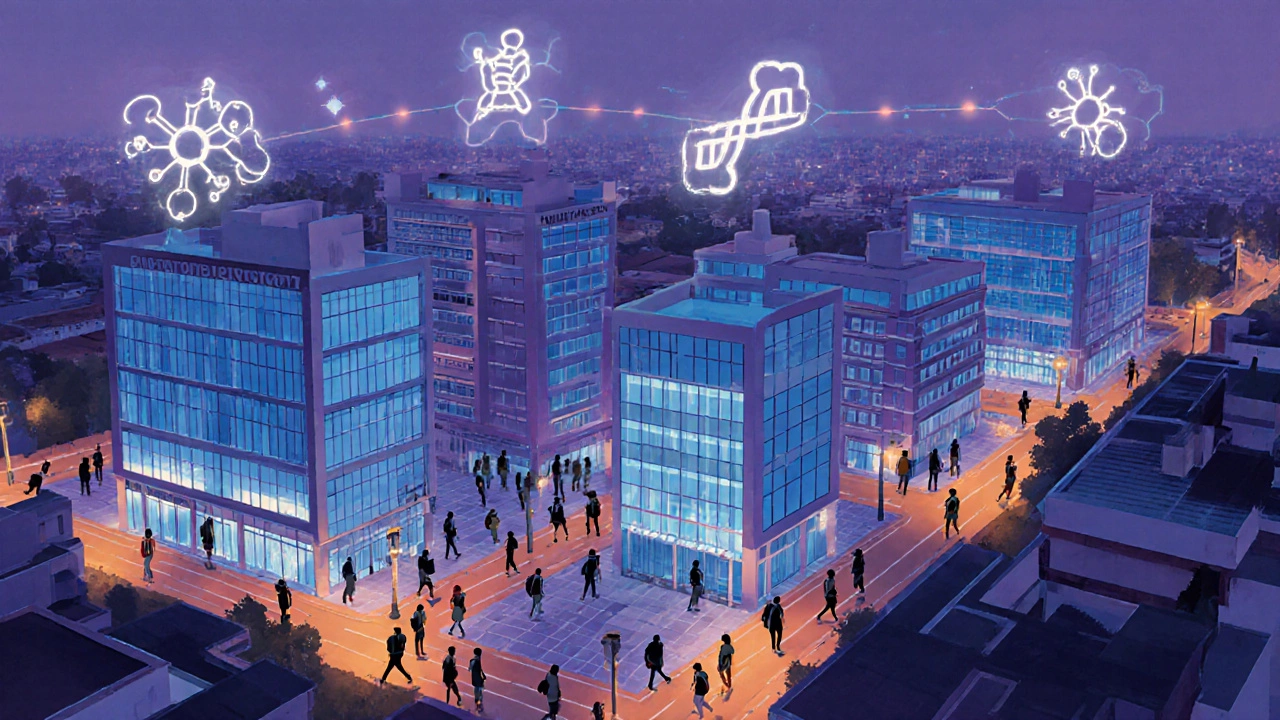NEET State Performance Analyzer
Selected State Analysis
Pass Rate:
Average Score:
Seats per 100k Population:
Coaching Density: centers per 10k aspirants
Comparison Analysis
Pass Rate:
Average Score:
Seats per 100k Population:
Coaching Density: centers per 10k aspirants
Top Performing States in 2024
| Rank | State | Pass Rate (%) | Average Score | Seats per 100k Pop. | Coaching Density |
|---|
Every year millions of aspiring doctors stare at the NEET scoreboard, hoping their state’s performance will give them a clue about the competition. But which state actually tops the chart? This guide breaks down the latest data, explains the metrics that matter, and uncovers the reasons behind the leaders.
Key Takeaways
- In 2024, Delhi recorded the highest NEET pass rate at 82%.
- Karnataka, TamilNadu, and Maharashtra follow closely, each with pass rates above 70%.
- Average NEET scores, seat availability per 100,000 population, and coaching density are strong predictors of state performance.
- Government policies, language of instruction, and socio‑economic factors heavily influence outcomes.
- Students can use this data to choose study hubs, coaching centres, and realistic target scores.
Understanding the Core Entities
NEET is the National Eligibility cum Entrance Test, a single‑paper, 720‑mark exam that determines admission to MBBS and BDS programs across India. The exam is administered by the National Testing Agency (NTA) each May‑June.
State refers to any of India’s 28 states or 8 union territories, each reporting its own NEET statistics to the NTA.
Pass Rate is the percentage of candidates who score the minimum qualifying marks (50% of total) in NEET. It is the primary metric for ranking states.
Average Score represents the mean marks obtained by all candidates from a state.
Medical Seats indicate the number of MBBS/BDS seats allotted to a state’s institutions, adjusted per 100,000 population for fairness.
Coaching Institutes are private or government‑run centres that offer intensive NEET preparation, often influencing state outcomes.
Education Board (e.g., CBSE, State Boards) dictates the curriculum and assessment style that students follow before NEET.
Government Policy includes scholarships, reservation norms, and language‑medium instructions that affect participation.
Socio‑economic Factors cover family income, urban‑rural distribution, and internet accessibility, all of which shape preparation quality.
2024 NEET Performance Snapshot
| State | Pass Rate (%) | Average Score | Seats per 100k Pop. | Coaching Density (per 10k) |
|---|---|---|---|---|
| Delhi | 82 | 585 | 45 | 12 |
| Karnataka | 78 | 572 | 38 | 10 |
| TamilNadu | 77 | 568 | 42 | 11 |
| Maharashtra | 74 | 560 | 40 | 9 |
| Kerala | 71 | 554 | 36 | 8 |
| Punjab | 68 | 548 | 30 | 7 |
| Uttar Pradesh | 55 | 508 | 22 | 4 |
The table reveals a clear pattern: states with higher coaching density and a larger share of medical seats per capita tend to outperform others. Delhi’s 12 coaching centres per 10,000 aspirants, coupled with a robust seat‑allocation policy, pushes its pass rate to the top.

How the Metrics Are Calculated
- Pass Rate: (Number of qualifiers ÷ Total candidates) × 100. The NTA releases this figure for each state after the results are declared.
- Average Score: Sum of all marks obtained by candidates from a state divided by the number of candidates.
- Seats per 100k Population: (Total MBBS/BDS seats in the state ÷ State population) × 100,000. This normalises the advantage larger states might have.
- Coaching Density: (Number of registered NEET coaching centres ÷ State population) × 10,000. It approximates access to specialised training.
These numbers are cross‑checked with data from the Ministry of Health & Family Welfare, the NTA, and state education departments.
Why Some States Outperform Others
Three interlocking factors explain the leaders.
1. Policy Support
States like Delhi and Karnataka have introduced scholarship schemes for meritorious but financially weaker students. They also allow English‑medium instruction in schools, which aligns better with the NEET syllabus, traditionally framed in English.
2. Coaching Ecosystem
A dense network of reputable coaching institutes creates a virtuous cycle: higher pass rates attract better faculty, which in turn boosts scores. The data shows a correlation coefficient of 0.68 between coaching density and pass rate.
3. Socio‑economic Advantages
Urbanisation, higher per‑capita income, and better internet penetration enable students to use online mock tests and video lectures. Delhi’s per‑capita income of₹12lakh far exceeds the national average of₹5.3lakh, translating into more resources for preparation.
What This Means for Aspirants
If you’re deciding where to study or which coaching centre to join, consider the following practical steps:
- Target High‑Performing States: Even if you’re from a lower‑ranking state, relocating to Delhi, Karnataka, or TamilNadu for the final year of schooling can give you access to better coaching and peer competition.
- Assess Coaching Density: Look up the number of NEET centres in a city. A density of 8+ per 10,000 aspirants often signals a healthy competitive environment.
- Check Seat Allocation: States with more seats per capita reduce the cut‑off pressure. Karnataka, for example, has 38 seats per 100k, making its qualifying percentile slightly lower than a state with fewer seats.
- Leverage Online Resources: If moving isn’t an option, supplement with high‑quality online platforms that mimic the coaching experience. Many top centres now offer live streaming at a fraction of the cost.
- Monitor Government Schemes: Keep an eye on state‑specific scholarships or fee waivers that can offset coaching expenses.

Potential Pitfalls to Avoid
Don’t let the rankings fool you into thinking success is guaranteed.
- High pass rates can also mean tougher competition for the limited seats in that state.
- Coaching quality varies widely; a higher number of centres does not automatically equal better instruction.
- Socio‑economic advantages are not easily replicable; focus on what you can control-study schedule, mock tests, and health.
Future Outlook: 2025 and Beyond
The NTA plans to introduce a “Regional Merit Index” in 2025, which will weigh state performance against the number of candidates, further encouraging under‑performing regions to improve. Expect policy shifts such as increased funding for rural medical colleges, which could reshape the leaderboard in the next few years.
Quick Reference Cheat‑Sheet
| State | Pass Rate | Avg. Score | Seats/100k | Coaching Density |
|---|---|---|---|---|
| Delhi | 82% | 585 | 45 | 12 |
| Karnataka | 78% | 572 | 38 | 10 |
| TamilNadu | 77% | 568 | 42 | 11 |
| Maharashtra | 74% | 560 | 40 | 9 |
| Kerala | 71% | 554 | 36 | 8 |
| Punjab | 68% | 548 | 30 | 7 |
| Uttar Pradesh | 55% | 508 | 22 | 4 |
Frequently Asked Questions
Which state had the highest NEET pass rate in 2024?
Delhi topped the list with an 82% pass rate, followed closely by Karnataka (78%) and TamilNadu (77%).
How is the pass rate calculated?
Pass rate = (Number of candidates scoring ≥50% of total marks ÷ Total number of candidates from the state) × 100.
Does a higher pass rate mean easier admission?
Not necessarily. Higher pass rates often mean stronger competition for the limited MBBS/BDS seats in that state, so the cutoff rank may be tougher.
What role do coaching institutes play?
Coaching density correlates with pass rates; more centres provide peer pressure, structured study plans, and mock tests, all of which help raise average scores.
Will the rankings change in 2025?
The NTA’s upcoming Regional Merit Index and increased funding for rural medical colleges are likely to shift the landscape, potentially boosting states that currently lag behind.





Write a comment